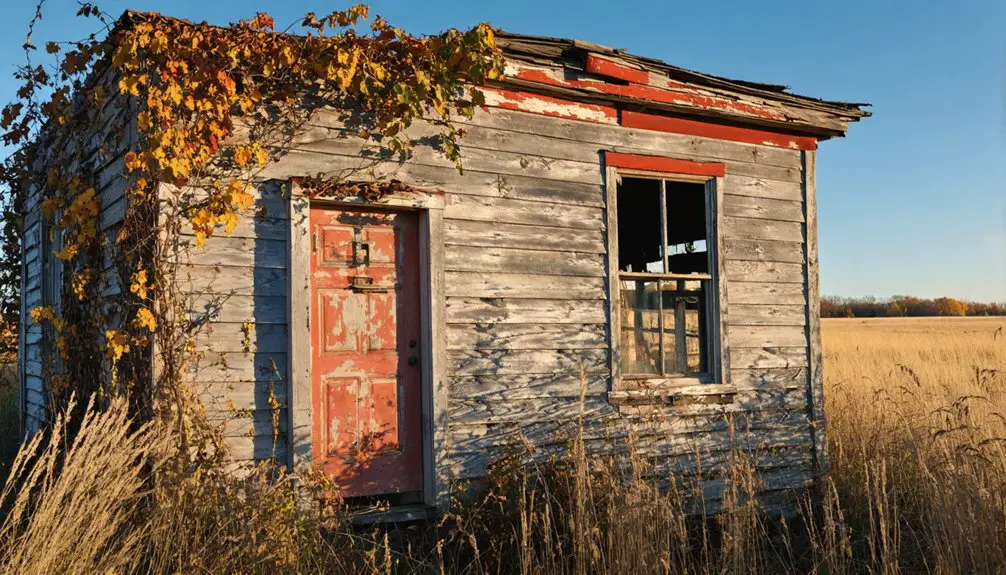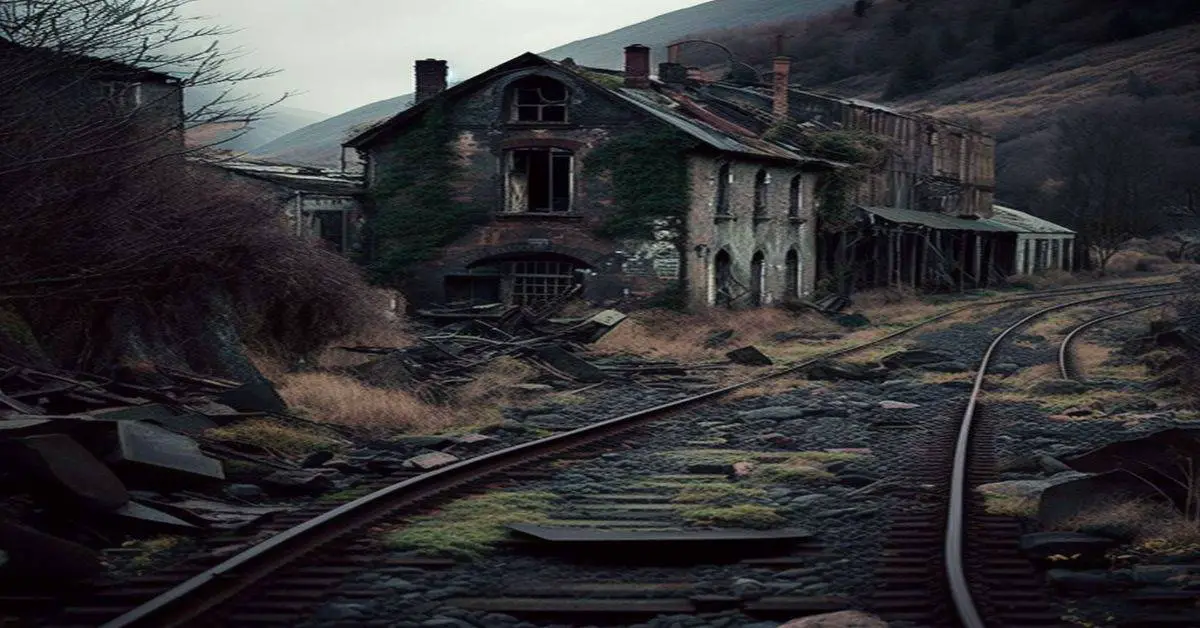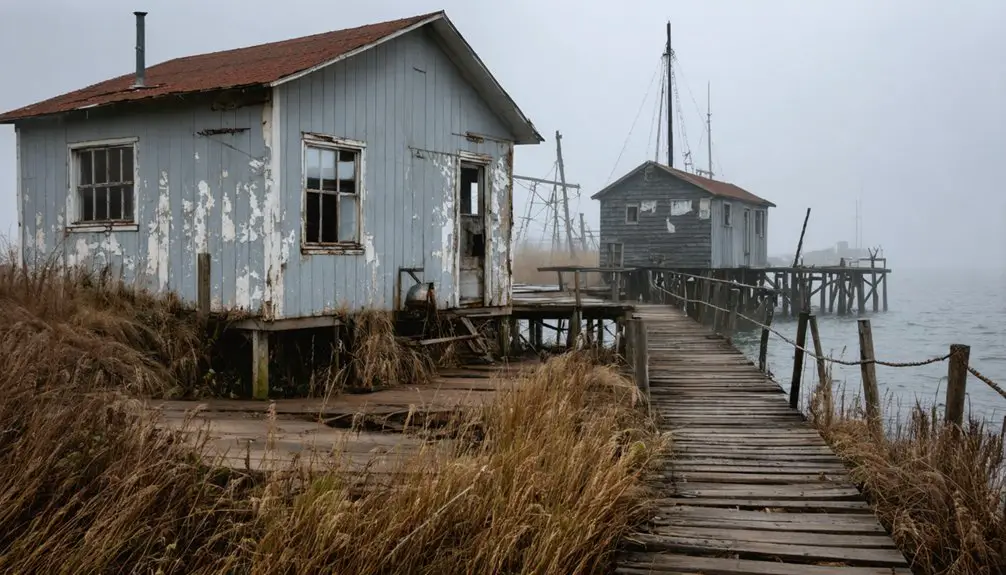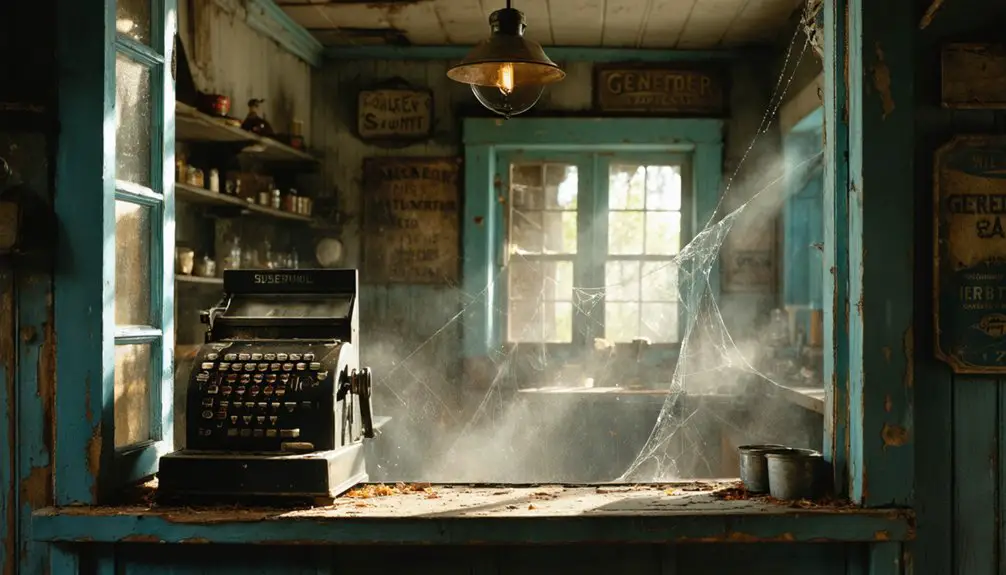You’ll find Port Ulao’s remains along Lake Michigan’s western shore, where James T. Gifford established this essential shipping hub in 1847. The town thrived through timber trade, using an innovative 1,000-foot pier and wooden chute system to fuel Great Lakes steamships. During Prohibition, it became a moonshine haven centered around the Ghost Town Tavern. Today, only five original structures survive, including the historic Guiteau house – each holding fascinating stories of Ulao’s dramatic rise and fall.
Key Takeaways
- Founded in 1847 as a Great Lakes shipping port, Ulao served as a vital refueling station for steamships traveling between Buffalo and Chicago.
- The town thrived through timber trade, featuring a 1,000-foot wooden pier and innovative chute system for loading wood onto ships.
- During Prohibition, Ulao transformed into a bootlegging hub, with Ghost Town Tavern becoming the center of underground entertainment activities.
- Only five original structures remain today, including the historic Guiteau family home and Ghost Town Tavern, now operating as a restaurant.
- The town’s decline began with Port Washington’s rise and the end of timber-based shipping, leaving Ulao as a historically significant ghost town.
The Birth of a Lake Michigan Port Town
In 1847, James T. Gifford from Elgin, Illinois recognized a prime opportunity along Lake Michigan’s towering clay bluffs. His founding vision transformed this strategic location into Port Ulao, a crucial refueling hub for Great Lakes steamships.
You’ll find Gifford’s transportation innovation impressive – he constructed a 1,000-foot wooden pier stretching into Lake Michigan and engineered a wooden chute system that allowed timber to slide down the 140-foot bluffs.
His sawmill and warehouse complex efficiently processed wood from nearby beech-maple forests that farmers were clearing. He’d also secured one of Wisconsin’s first turnpike charters, connecting Port Ulao to Grafton via a three-mile plank road. The bustling port town developed from early Yankee-Yorker settlements of the 1830s and 1840s.
This infrastructure positioned the port perfectly to capitalize on the steamship industry‘s voracious appetite for cordwood fuel, making it a preferred stop for vessels avoiding Milwaukee’s treacherous sandbar. The port’s success led Gifford to hire Luther Guiteau to survey the expanding settlement in 1850.
From Timber Trade to Economic Glory
While early settlers cleared Wisconsin’s abundant forests for farmland, Ulao’s timber trade flourished as Gifford’s strategic operation transformed raw wood into profitable commerce.
You’d find his 1,000-foot pier stretching into Lake Michigan, where a clever chute system delivered wood directly to steamships that consumed massive amounts of fuel – a single Buffalo-to-Chicago voyage required 500 cords, enough trees to clear ten acres.
Gifford’s economic vision didn’t stop at the shoreline. He secured Wisconsin’s first turnpike charter in 1847, building three miles of innovative road westward using charcoal-clay surfacing.
Pioneering ingenuity marked Gifford’s inland expansion, as his groundbreaking charcoal-clay turnpike helped connect Wisconsin’s frontier to commerce.
The timber importance of Ulao grew as steamer captains preferred its accessible harbor over Milwaukee’s treacherous approach. The development mirrored how Wisconsin River settlements transformed into major urban centers around water-powered mills. Before its eventual economic decline, Ulao served as a crucial hub connecting Wisconsin’s inland forests to Great Lakes commerce. The thriving port community expanded to include a tavern and dance hall, which became local landmarks.
Notable Citizens: The Guiteau Connection
Among Ulao’s most notorious residents, Charles Guiteau arrived as a young child in 1850 when his father Luther, a respected surveyor, relocated the family from Freeport, Illinois at Captain James T. Gifford’s request.
The Guiteau legacy in Ulao history began in their cream city brick home at 782 Ulao Road, where they lived until 1855 when Charles’ mother’s death prompted their return to Freeport. After inheriting $1,000 from his grandfather, Charles attempted but failed the University of Michigan entrance exams.
- Charles attended Ulao’s school for five years, already showing signs of his high-strung personality.
- The family’s presence coincided with Ulao’s economic timber trade boom.
- Their historic home still stands today as a reminder of this darker chapter.
Charles later gained infamy as President Garfield’s assassin in 1881, forever linking this quiet Wisconsin town to a national tragedy. Growing up in troubled isolation, Guiteau’s early years in Ulao would foreshadow his later mental instability.
Life Along the Great Lakes Shore
Situated atop 140-foot clay bluffs overlooking Lake Michigan, Ulao emerged in 1847 as an essential refueling port for Great Lakes steamships.
Perched high above Lake Michigan’s waters, Ulao served as a crucial maritime fuel station in the mid-1800s.
You’d find a bustling scene at the 1000-foot wooden pier, where crews docked their vessels needing massive amounts of fuel – a single ship could burn through wood from 10 acres in one journey.
The town’s innovative transport system defined lakeside life, with a wooden chute running down the steep bluffs to efficiently move cordwood to waiting ships.
While fishing culture and lakeside recreation weren’t Ulao’s primary focus, the community thrived on maritime trade throughout the 1850s and 1860s.
Local taverns served as gathering spots for sailors, farmers, and wood suppliers, creating a vibrant shoreline community until coal eventually replaced wood as ships’ primary fuel.
The port town was established by James T. Gifford, who strategically built a sawmill and warehouse to capitalize on the growing maritime fuel trade.
The Prohibition Years: Moonshine and Dancing
After Ulao’s decline as a timber port in the early 1900s, the town found new life during Prohibition as a haven for moonshine production and underground entertainment.
The rural location and railroad access made Ulao perfect for a thriving moonshine culture, with illicit spirits flowing freely through distribution networks to nearby cities. Today, the town stands near the I-43/Highway 32/57 interchange.
The Ghost Town Tavern & Dance Hall became the epicenter of Ulao’s underground economy, where you’d find:
- Nightly parties with illegal drinking and dancing
- Open gambling and card games
- “Wild and woolly” entertainment drawing both locals and visitors
This vibrant nightlife helped sustain Ulao through the 1920s and 1930s, transforming a fading lumber town into an exciting destination for those seeking freedom from Prohibition’s restrictions.
The tavern’s activities provided financial opportunities for remaining residents while delaying the town’s eventual decline.
Port Washington’s Rise and Ulao’s Fall
While Ulao found temporary life through Prohibition-era entertainment, Port Washington’s meteoric rise as a regional powerhouse spelled the end for its smaller neighbor.
You can trace the settlement patterns back to 1846, when Port Washington’s formal platting attracted speculators drawn to its prime Lake Michigan location and rich loamy soil. By 1853, its population had swelled to 2,500, bolstered by German and Luxembourg immigrants.
The economic shifts were stark. While Ulao remained dependent on lumber and shipping, Port Washington diversified after the Lake Shore Railroad’s arrival in 1870. The town’s Druecker Stone Quarry became a major supplier of building materials, providing stone for local landmarks like St. Mary’s Church. The city’s development was further enhanced when it became the county seat of Ozaukee in 1853 after separating from Washington County.
The larger city leveraged its natural advantages – from Sauk Creek’s water power to lakeside quarries – developing foundries, mills, and manufacturing.
Without similar infrastructure investments or rail connections, Ulao couldn’t compete and gradually faded into obscurity.
Modern Traces of a Forgotten Community
If you visit Ulao today, you’ll find only five original structures marking the ghost town‘s former location, including Charles Guiteau’s childhood brick home and the historic Ghost Town Tavern that once hosted illicit activities during Prohibition.
Along Lake Michigan’s shore, weathered pier pilings emerge from the water where Ulao’s bustling port infrastructure once facilitated the loading of grain and wood onto passing steamships.
The site’s remaining buildings now serve new purposes, with the grain mill transformed into part of the Grafton Antique Mall and the Ghost Town Tavern operating as a restaurant, while scattered grave markers and railroad tracks offer subtle reminders of the vanished community.
Physical Remnants Today
Though time has erased much of Ulao’s original footprint, several notable structures from this once-thriving Lake Michigan port town remain standing today in present-day Grafton.
You’ll find five remnant structures that offer glimpses into the ghost town’s past:
- The Guiteau family home, where President Garfield’s assassin once lived, stands preserved as a symbol of the town’s historical significance.
- The Ghost Town Tavern & Restaurant, formerly Ulao’s original tavern and dance hall, continues serving patrons just as it did during Prohibition.
- The historic grain mill and elevator complex now houses the Grafton Antique Mall.
Beyond these buildings, you can explore deteriorating wooden piers along Lake Michigan’s shore and discover the innovative log chute system carved into the steep bluffs.
Railroad foundations and scattered artifacts remind visitors of Ulao’s bustling past as a shipping hub.
Hidden Historical Markers
Despite its ghostly status, Ulao’s legacy lives on through a network of historical markers scattered across present-day Grafton.
You’ll find hidden markers near the original pier site commemorating Port Ulao‘s role as a Lake Michigan shipping hub, while signs along the bluff tell the story of James T. Gifford’s 1847 establishment of the wood shipping center.
The historical significance of the area is further detailed through interpretative panels explaining the wooden chute system and the town’s eventual decline as ships switched from wood to coal fuel.
Near the old Chicago & Northwestern line, you’ll discover markers highlighting the railroad station’s impact, while others document the infamous Charles Guiteau’s childhood home and the once-bustling Ghost Town Tavern & Dance Hall from the Prohibition era.
Preserving Ulao’s Memory
While many ghost towns fade completely into obscurity, Ulao’s physical presence endures through five original structures that stand as evidence to its vibrant past.
Through community engagement and historical storytelling, you’ll find these remnants preserving the town’s legacy:
- The Guiteau home, built of Milwaukee cream city brick, offers a tangible link to Charles Guiteau’s childhood and the town’s early settlement.
- The former grain mill and elevator, now part of Grafton Antique Mall, maintains architectural elements that showcase Ulao’s commercial heritage.
- The Ghost Town Tavern & Restaurant continues serving patrons, keeping alive the spirit of social gathering that defined the original community.
Digital archives, museum exhibits, and local heritage organizations work to document and share Ulao’s unique story, ensuring future generations can connect with this slice of Wisconsin history.
Frequently Asked Questions
Are There Any Remaining Structures or Ruins Visible in Ulao Today?
You’ll find five remaining buildings, including the Ghost Town Tavern and Charles Guiteau’s childhood home. While historical artifacts like pier pilings exist underwater, most original structures have disappeared over time.
What Happened to the Original 1000-Foot Wooden Pier?
You won’t find the original pier construction today – after its decline in the late 1800s, the wooden structure naturally deteriorated into Lake Michigan, leaving only its historical significance in Great Lakes maritime records.
How Many People Lived in Ulao During Its Peak Years?
You’d love how historians can’t nail down exact numbers, but based on peak economic activity in the 1850s-60s, your freedom-loving ancestors probably numbered between 100-300 before population growth reversed into decline.
Can Visitors Access the Historical Site of Ulao?
You can visit the site’s general area, but there’s no maintained historical access. While local legends and ghost sightings draw interest, you’ll mainly find abandoned land near Lake Michigan’s shore.
Were There Any Notable Shipwrecks Near Ulao’s Port?
Fortune favors the curious, but you won’t find major shipwreck history at Port Ulao. While Lake Michigan claimed many vessels nearby, no significant maritime artifacts or documented wrecks exist at this specific location.
References
- https://juicesghostown.com/history/why-ghost-town/
- https://lakecountrytribune.com/exploring-the-haunting-echoes-of-wisconsins-ghost-towns/
- https://www.cultofweird.com/travel/charles-guiteau-wisconsin-ghost-town/
- https://www.wisconsinfrights.com/charles-guiteau-home-ulao/
- https://en.wikipedia.org/wiki/Ulao
- https://emke.uwm.edu/entry/town-of-grafton/
- https://www.townofgraftonwi.gov/town-history/
- https://www.wisconsinhistory.org/Records/Article/CS409
- https://wi101.wisc.edu/the-lumber-industry-in-northern-wisconsin/
- https://mywisconsinwoods.org/2022/09/30/looking-back-at-the-history-of-wisconsin-forests/



